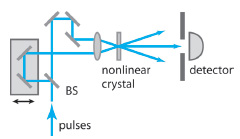Autocorrelator
An autocorrelator is a device for determining the autocorrelation function of an input signal. To the main implementations of such a device include the optical autocorrelator that allows the duration of the ultrashort light pulses to be determined. There are also realizations in digital electronics, for example, be used to to measure the dynamics of diffusing particles in fluorescence correlation spectroscopy or dynamic light scattering.
- 3.1 Linear correlator
- 3.2 multi- τ correlator
General Description
An autocorrelator is calculated from an input signal I (t) whose autocorrelation function
This sheds light on the self-similarity of the signal I (t ) with a delay τ and thus allows even those signals to analyze the hidden in noise ( eg in fluorescence correlation spectroscopy, as is true for the autocorrelation function of white noise ), or too fast for a normal detection ( see Optical autocorrelator ) are.
Optical autocorrelator
Background
A temporal resolution of a light pulse in the picosecond or femtosecond range is not possible with the photodiodes, since the speed of a photodiode is limited by the recombination time of the electron -hole pairs, which is typically greater than 100 picoseconds. Thus, to resolve a light pulse in time it takes the reference processes, which are shorter than the event to be measured. This is only possible by optical methods. In an autocorrelator, the pulse measured "with themselves " as a reference.
Design and operation
The picture shows a possible implementation of an autocorrelator. He is basically a Michelson interferometer dar. The incident pulse is first split into a beam splitter into two parts. These run through independently different ways and are then brought together again in the beam splitter. Meet the combined pulse to a nonlinear crystal (for example, BBO ) in which the frequency -doubled ( second-harmonic ) of the incident light is generated. The conversion efficiency, so the intensity of the second harmonic depends on the intensity of light in the crystal. This in turn depends on the time delay between the two pulses. This offset is ( in the map M2 ) is set by a mirror, which is mounted on a variable delay line. The autocorrelation of the incident pulse is thus measured by measuring the intensity of the frequency- doubled light as a function of time offset. This suggests that, assuming the underlying pulse shape determine the duration.
Mathematical Description
A pulse of the temporal intensity distribution is first split into two pulses, and reunited. As the pulses pass through different paths, they have a time delay to each other:
The intensity of the frequency-doubled light in the nonlinear crystal where:
The detector then measures the time average of the 2nd harmonic, as its time constant is much greater than the pulse duration:
In an autocorrelator with a non-interfering beam path results in:
Here, the angle brackets < · > denote the time average. The last summand is just the autocorrelation function of the temporal intensity distribution of the measured pulse dar. Assuming the pulse shape can now calculate its duration.
If the pulse is not doubled after superposition in the frequency of light, the detector would measure a signal that is independent of the time delay. Thus is recovered so that no information about the intensity of the pulse. Can be very fine, slowly and reproducibly adjusted as opposed to an autocorrelator of deceleration, such as with an FTIR spectrometer, optical frequency doubling is not necessary and the resulting interferogram from the pulse duration can also be determined.
Electronic autocorrelator
Linear correlator
An electronic autocorrelator calculated from an analogue or digital input signal I (t) whose autocorrelation function. In many areas, the input signals are digitized now and then processed by a so-called linear or multi- τ autocorrelator. The basic structure of a linear autocorrelator is shown on the right. The input signal is delayed by discrete steps () and multiplied by the undelayed input signal. The result is summed. As a discrete estimation of the autocorrelation function is carried out:
Here, the continuous input signal is decomposed into N discrete steps in. The series-connected delay stages may be realized by using a shift register. For the first realizations and special applications (eg high speed) this project have been developed special micro chip ( ASIC), later productions using FPGAs and / or digital signal processors ( DSPs). In the latter architectures called multiply-accumulate instructions or blocks are available with which the autocorrelation can be done very efficiently, since they exactly ( multiply two numbers and then sum ) single-step illustrated on the right realize.
Multi- τ correlator
An extension of the linear correlator represents the so-called multi - τ correlator which combines several linear stages. Between the steps, the signal is in over (typically 2 ) summed time periods. The next step then correlates the signal. Thus, a semi- logarithmic distribution of the delays τk is achieved and it can with relatively little hardware overhead, a large delay range are scanned.









